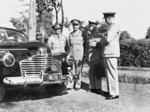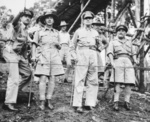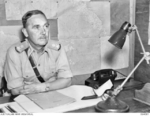Edmund Herring
| Surname | Herring |
| Given Name | Edmund |
| Born | 2 Sep 1892 |
| Died | 5 Jan 1982 |
| Country | Australia |
| Category | Military-Ground |
| Gender | Male |
Contributor: C. Peter Chen
ww2dbaseEdmund Francis Herring was the third of five children of Edmund Selwyn Herring and Gertrude Stella Herring, née Fetherstonhaugh. He attended Maryborough College and High School in the city of his birth, and at Melbourne Grammar, both of which were in Australia. While at Melbourne Grammar, he served in the Commonwealth Cadet Corps, reaching the rank of sergeant. In 1911, he enrolled in Trinity College, which was the Church of England residential college at the University of Melbourne. In 1912, he won a Rhodes Scholarship to the University of Oxford in England, United Kingdom. In 1913, he joined the British Army Officers Training Corps, leading to his enlistment with the King Edward's Horse (later renamed 1st King Edward's Horse) cavalry regiment in Nov 1913. King Edward's Horse was mobilized in Aug 1914, but remained in Britain for several months; in the mean time, Herring was promoted to the rank of second lieutenant in the Royal Field Artillery. He was deployed to France in Aug 1915 with B Battery, 99th Field Artillery Brigade, British 22nd Division. In Sep 1915, he was transferred to the Macedonian front, where he would remain for the remainder of WW1, save a period of leave between Oct 1917 and Mar 1918. Between Oct 1918 and Jan 1919, he was the commanding officer of B Battery, 99th Field Artillery Brigade. Returning to University of Oxford after WW1, he received a Bachelor of Civil Law degree and Master of Arts degree in Jul 1920. He married Mary Ranken Lyle, whom he had met during a 1917-1918 home leave during WW1, in 1922; they would have three daughters together. During the inter-war years, he practised both civilian law as well as military law. In his civilian career, he was elected to the Melbourne Club in 1927, became the club's president in 1928, and unsuccessfully ran for a seat in the legislature in 1931 and 1936. In the military, he became a legal staff officer first with the Australian militia and later with the Australian Field Artillery, being promoted to the rank of major in 1925 and lieutenant colonel in 1929. As the European political tension heightened in Aug 1939, he was promoted to the rank of temporary colonel and was given command of the Australian 3rd Division Artillery.
ww2dbaseAfter the European War began in Sep 1939, Herring was appointed by Major General Thomas Blamey as the commanding officer of Royal Artillery units within 6th Division of Second Australian Imperial Force; a week later, he was promoted to the permanent rank of colonel and temporary rank of brigadier for this assignment. In this role, he directed actions at Bardia and Tobruk in Libya and then Greece. After being evacuated from Crete, Greece to Egypt, he was made a Commander of the Order of the British Empire for his service thus far. Made a temporary major general in Aug 1941, he took command of Australian 6th Division in Egypt. In Mar 1942, 6th Division returned to Australia. In Apr 1942, he was given command of Northern Territory Force; in this role he planned for the defense of Northern Territory in the case of a Japanese landing. In Aug 1942, he was given command of Australian II Corps at the temporary rank of lieutenant general. Shortly after, he was made the commanding officer of I Corps, which was based in Port Moresby, Australian Papua; in this role, he was credited with effective management of logistics in bringing supplies to the remote colonial capital and then to the front lines along the Kokoda Track. In Nov 1942, he flew to the front at Buna to direct operations from the front. For the subsequent victory at Buna, he was made Knights Commander of the Order of the British Empire and was awarded a brief leave for rest. He returned to New Guinea island in May 1943, commanding I Corps in the capture of Japanese bases along the northern coast of New Guinea island. Despite his successes in the field, he was recalled to Australia, where he would develop amphibious warfare doctrine.
ww2dbaseIn Feb 1944, the aged Herring retired from military service and was appointed Chief Justice of the Supreme Court of Victoria, Australia. In 1945, he was given the concurrent position as the Lieutenant Governor of Victoria. In 1949, he was made a Knight Commander of the Order of Saint Michael and Saint George. In Aug 1950, he was recalled to the military to serve as the Director General of Recruiting. In Jan 1953, he was made the leader of the Australian Services Contingent for the coronation of Queen Elizabeth II of the United Kingdom; after the coronation ceremonies, he was made a Knight of the Order of Saint John at Buckingham Palace in London (his wife was made a Commander of the Order of St John at the same time for her charity work). He retired his position of Chief Justice of the Supreme Court of Victoria in 1964 and Lieutenant Governor of Victoria in 1972. After WW2, he also held several postings outside of his government work, including being the first President of the Australian Boy Scouts Association, Chairman of Trustees of the Shrine of Remembrance, Chairman of Trustees of the Australian War Memorial, a fellow of New College of Oxford, and others. He passed away in a nursing home in Camberwell, Victoria in 1982. He was given a state funeral at Saint Paul's Cathedral in Melbourne, Australia.
ww2dbaseSource: Wikipedia
Last Major Revision: Aug 2014
Edmund Herring Interactive Map
Photographs
 |  |  |  |
Edmund Herring Timeline
| 2 Sep 1892 | Edmund Herring was born in Maryborough, Victoria, Austria. |
| 1 Jan 1918 | Edmund Herring met Mary Ranken Lyle in Maryborough, Victoria, Australia. |
| 24 Oct 1918 | Edmund Herring was promoted to the rank of acting major and took command of B Battery, 99th Field Artillery Brigade of the British Army. |
| 22 Jan 1919 | Edmund Herring returned to his former rank of lieutenant and stepped down as the commanding officer of B Battery, 99th Field Artillery Brigade of the British Army. |
| 26 Nov 1920 | Edmund Herring arrived in Melbourne, Australia. |
| 1 Mar 1921 | Edmund Herring was admitted to practice law as a barrister and solicitor in Victoria, Australia. |
| 8 Jun 1921 | Edmund Herring signed the roll of counsel of the Victorian Bar. |
| 6 Apr 1922 | Edmund Herring married Mary Ranken Lyle. |
| 1 Aug 1923 | Edmund Herring transferred to the Australian Field Artillery of Australian Army. |
| 1 Jul 1925 | Edmund Herring was promoted to the rank of major. |
| 1 Jul 1929 | Edumnd Herring was promoted to the rank of lieutenant colonel. |
| 25 Feb 1936 | Edmund Herring became a King's Counsel. |
| 1 Aug 1939 | Edmund Herring was promoted to the rank of temporary colonel and was given command of the Australian 3rd Division Artillery. |
| 6 Oct 1939 | Edmund Herring was named the commanding officer of Royal Artillery units within 6th Division of Second Australian Imperial Force; the appointment was made by Major General Thomas Blamey. |
| 15 Apr 1940 | Edmund Herring departed Australia for Palestine as a part of Major General Iven Mackay's headquarters. |
| 14 Aug 1941 | Edmund Herring was promoted to the temporary rank of major general and was given command of Australian 6th Division in Egypt. |
| 14 Aug 1942 | Edmund Herring was promoted to the temporary rank of lieutenant general and was given command of Australian II Corps at Esk, Queensland, Australia. |
| 28 Sep 1943 | Edmund Herring and his staff officers R. B. Sutherland and R. Bierwirth boarded a USAAF B-25 bomber at Dobodura Airfield on New Guinea island for transport to Milne Bay. The undercarriage of the aircraft collapsed during takeoff, causing the propeller to break pieces off of the Marston Mat; Sutherland was struck and killed by one such piece. |
| 2 Feb 1944 | Edmund Herring was appointed Chief Justice of the Supreme Court of Victoria, Australia. |
| 9 Jun 1949 | Edmund Herring was made a Knight Commander of the Order of Saint Michael and Saint George. |
| 26 May 1953 | Edmund Herring personally led Australian troops in guarding Queen Elizabeth II at the Buckingham Palace in London, England, United Kingdom during the queen's coronation ceremonies. |
| 10 Jul 1953 | Edmund Herring was made a Knight of the Order of Saint John at Buckingham Palace in London, England, United Kingdom. |
| 2 Sep 1972 | Edmund Herring stepped down as the Lieutenant Governor of Victoria, Australia. |
| 5 Jan 1982 | Edmund Herring passed away in Camberwell, Victoria, Australia. |
Please consider supporting us on Patreon. Even $1 per month will go a long way! Thank you. Please help us spread the word: Stay updated with WW2DB: |
Visitor Submitted Comments
All visitor submitted comments are opinions of those making the submissions and do not reflect views of WW2DB.

» Balkans Campaign
» Siege of Tobruk
» Operation Crusader
» New Guinea-Papua Campaign, Phase 2
» New Guinea-Papua Campaign, Phase 3
- » 1,176 biographies
- » 337 events
- » 44,933 timeline entries
- » 1,245 ships
- » 350 aircraft models
- » 207 vehicle models
- » 376 weapon models
- » 123 historical documents
- » 261 facilities
- » 470 book reviews
- » 28,471 photos
- » 365 maps
James Forrestal, Secretary of the Navy, 23 Feb 1945
Please consider supporting us on Patreon. Even $1 a month will go a long way. Thank you!
Or, please support us by purchasing some WW2DB merchandise at TeeSpring, Thank you!
10 Dec 2016 01:29:33 AM
A blot on Herring's reputation is the execution of the men from Higari in Oro Providence. Most of those executed had no English let alone Pigin. Despite the atrocities committed the Higari Men did not receive a proper trial